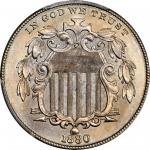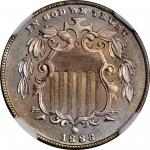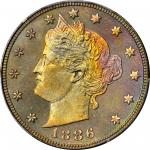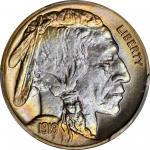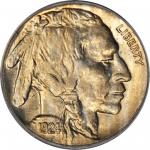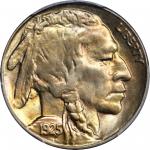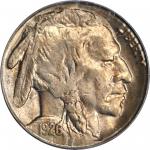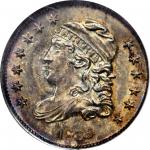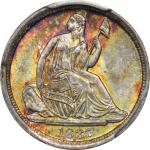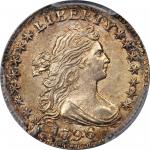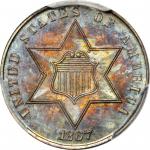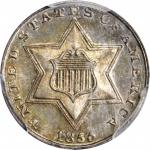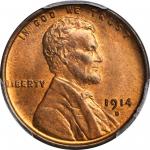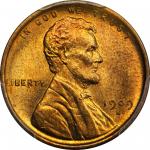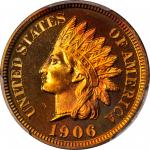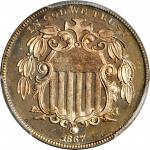1867 Shield Nickel. Rays. Proof-66 Cameo (PCGS).One of the rarest of the early Proof issues and a key date to the Shield nickel series, the Proof 1867 Rays has a mintage estimated at only 55 to 80 specimens. The present example is tied with a select few as the finest certified by PCGS. The obverse features strong reflectivity in the fields while the devices show satiny elegance. Toned with a dash of russet-gold on the obverse devices, a bit more of this iridescence is found in the central reverse. The diagnostics of this rare Proof coin are all present: the thin center ray below the second letter T in STATES and traces of unfinished die polishing in the lower part of the shield and within the letter E in UNITED. Of course the strike is full and complete, as expected for a Proof of this time period. This is an imposing example of this enormously popular early Proof Shield nickel, exhibiting the Rays style that was officially used only in 1866 and part of 1867.Introduced in 1866, the copper-nickel five-cent piece has remained an integral part of our nations coinage ever since. The origins of this coin were born out of the suspension of specie payments during the Civil War. Gold coins disappeared from circulation in late 1861 and silver coins in the spring of 1862. Initially the silver half dime was replaced with five-cent Fractional Currency notes, which circulated well after the war concluded in 1865. In order to provide an alternative to these notes, Congress followed the nickel three-cent pieces of 1865 with similar five-cent copper-nickel coins authorized by the Act of May 16, 1866. Both denominations had planchets composed of 75% copper blended with 25% nickel. When initially discussed the proposed weight of the new copper-nickel coin was to be around 30 grains, or about one and a half times the existing but not currently circulating silver half dime. As discussions progressed, Joseph Wharton, whose companys nickel output was larger than any other and who essentially controlled the market, convinced Congress to increase the weight to 77 grains, thereby using more nickel for each coin produced. Mint Engraver James Barton Longacre designed the new coin, with the obverse displaying a large central shield with arrows crossed at its base, draped in a hanging wreath with a broad cross above. The date is below and the motto IN GOD WE TRUST is in small letters at the top. For the reverse a large Arabic numeral 5 is central, with 13 small stars surrounding and 13 glory rays, each alternating in sequence, around the 5. Above the denomination is the legend UNITED STATES OF AMERICA and the word CENTS is below.The inclusion of the rays on the reverse proved to be problematic. The combination of copper and nickel produced a very hard planchet that was difficult to strike up fully with the intended designs. Furthermore the nickel alloy was so hard that the dies soon developed cracks and did not last long during the coining process. When complaints reached Treasury Secretary McCulloch, he promptly ordered the rays be removed on January 21, 1867, and production was halted until new dies could be created, which came into production on February 1, 1867.Research by R.W. Julian has confirmed that Chief Coiner Snowden delayed striking Proof 1867 nickels for inclusion in annual Proof sets until the modified No Rays design was ready. However, it is entirely likely that Mint Director Henry R. Linderman had the 1867 Rays Proofs struck clandestinely to be distributed to his collector friends, as was common during his tenure at the Mint. The fact that at least four different die marriages exist for this rare Proof issue (per the research of John Dannreuther, in particular) seems to point to multiple striking periods. Indeed, Dannreuther (as related in Bowers, <em>A Guide Book of Shield and Liberty Head Nickels</em>, 2006) believes that 15 "originals" were struck in 1867, followed by 50 or more examples during at least five later production runs. These coins, especially the later strikings, were probably made at the request of contemporary dealers -- including John W. Haseltine -- with close ties to Mint personnel who needed examples for their clients.The Proof 1867 Rays is one of the great classic rarities among late 19th century Proof minor coins. The others in this category are the 1864 Indian cent with L on Ribbon and the 1864 Small Motto two-cent piece. It is usually the situation that the Proof 1867 Rays nickel is the last to be acquired in a full set. If you are a specialist this may well complete your holdings. If you are contemplating becoming a specialist, why not start at the top with this piece? The others should prove easier to find.From the High Rise Collection. Earlier from our Chicago ANA Sale of August 2014, lot 13049.

